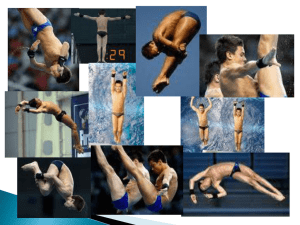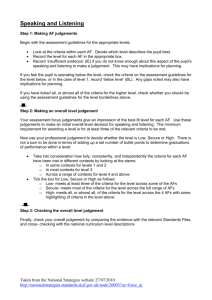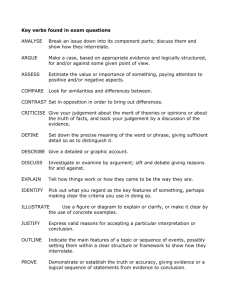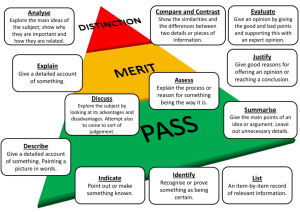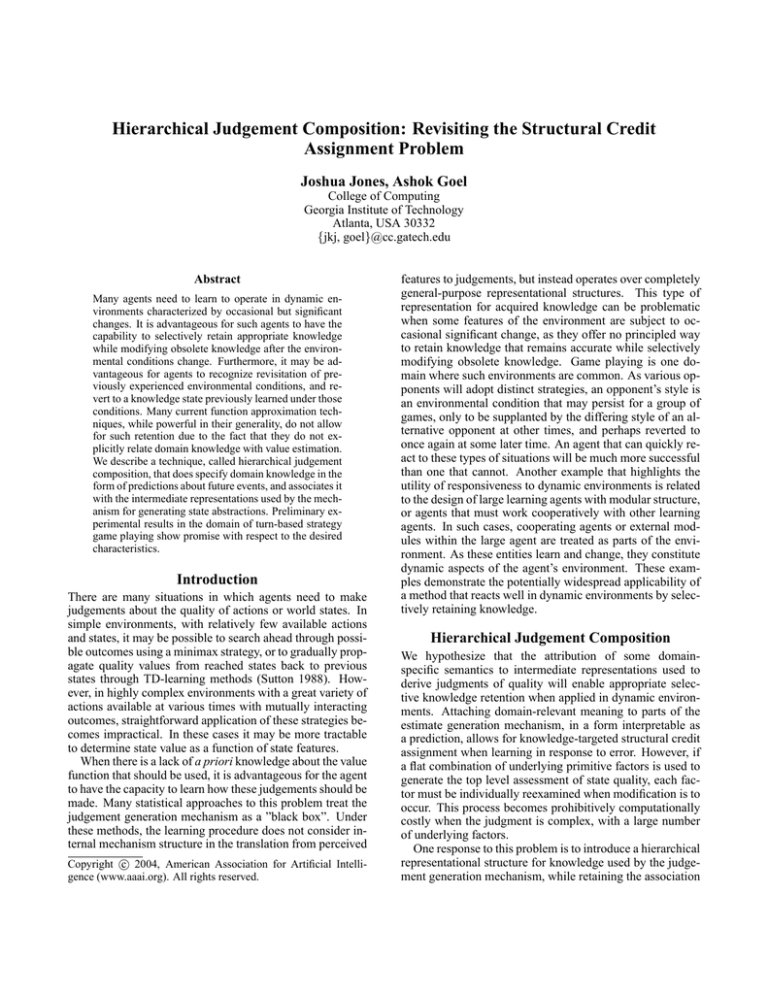
Hierarchical Judgement Composition: Revisiting the Structural Credit
Assignment Problem
Joshua Jones, Ashok Goel
College of Computing
Georgia Institute of Technology
Atlanta, USA 30332
{jkj, goel}@cc.gatech.edu
Abstract
Many agents need to learn to operate in dynamic environments characterized by occasional but significant
changes. It is advantageous for such agents to have the
capability to selectively retain appropriate knowledge
while modifying obsolete knowledge after the environmental conditions change. Furthermore, it may be advantageous for agents to recognize revisitation of previously experienced environmental conditions, and revert to a knowledge state previously learned under those
conditions. Many current function approximation techniques, while powerful in their generality, do not allow
for such retention due to the fact that they do not explicitly relate domain knowledge with value estimation.
We describe a technique, called hierarchical judgement
composition, that does specify domain knowledge in the
form of predictions about future events, and associates it
with the intermediate representations used by the mechanism for generating state abstractions. Preliminary experimental results in the domain of turn-based strategy
game playing show promise with respect to the desired
characteristics.
Introduction
There are many situations in which agents need to make
judgements about the quality of actions or world states. In
simple environments, with relatively few available actions
and states, it may be possible to search ahead through possible outcomes using a minimax strategy, or to gradually propagate quality values from reached states back to previous
states through TD-learning methods (Sutton 1988). However, in highly complex environments with a great variety of
actions available at various times with mutually interacting
outcomes, straightforward application of these strategies becomes impractical. In these cases it may be more tractable
to determine state value as a function of state features.
When there is a lack of a priori knowledge about the value
function that should be used, it is advantageous for the agent
to have the capacity to learn how these judgements should be
made. Many statistical approaches to this problem treat the
judgement generation mechanism as a ”black box”. Under
these methods, the learning procedure does not consider internal mechanism structure in the translation from perceived
c 2004, American Association for Artificial IntelliCopyright gence (www.aaai.org). All rights reserved.
features to judgements, but instead operates over completely
general-purpose representational structures. This type of
representation for acquired knowledge can be problematic
when some features of the environment are subject to occasional significant change, as they offer no principled way
to retain knowledge that remains accurate while selectively
modifying obsolete knowledge. Game playing is one domain where such environments are common. As various opponents will adopt distinct strategies, an opponent’s style is
an environmental condition that may persist for a group of
games, only to be supplanted by the differing style of an alternative opponent at other times, and perhaps reverted to
once again at some later time. An agent that can quickly react to these types of situations will be much more successful
than one that cannot. Another example that highlights the
utility of responsiveness to dynamic environments is related
to the design of large learning agents with modular structure,
or agents that must work cooperatively with other learning
agents. In such cases, cooperating agents or external modules within the large agent are treated as parts of the environment. As these entities learn and change, they constitute
dynamic aspects of the agent’s environment. These examples demonstrate the potentially widespread applicability of
a method that reacts well in dynamic environments by selectively retaining knowledge.
Hierarchical Judgement Composition
We hypothesize that the attribution of some domainspecific semantics to intermediate representations used to
derive judgments of quality will enable appropriate selective knowledge retention when applied in dynamic environments. Attaching domain-relevant meaning to parts of the
estimate generation mechanism, in a form interpretable as
a prediction, allows for knowledge-targeted structural credit
assignment when learning in response to error. However, if
a flat combination of underlying primitive factors is used to
generate the top level assessment of state quality, each factor must be individually reexamined when modification is to
occur. This process becomes prohibitively computationally
costly when the judgment is complex, with a large number
of underlying factors.
One response to this problem is to introduce a hierarchical
representational structure for knowledge used by the judgement generation mechanism, while retaining the association
of domain knowledge with the internals of the representation. Rather than directly producing a complex estimate by
combining a large set of primitive features, small groups of
low level features are used to produce intermediate level
judgements. Intermediate level judgements and primitive
features are then combined into small groups to form successively higher level estimates. If each of the intermediate
judgments can be interpreted as a prediction, and thus directly evaluated for correctness against observable environmental conditions at future times, more efficient knowledge
update is possible when error is detected.
In this study, we evaluated these ideas for a fairly small
subset of a larger domain to insure that the concepts are
workable and allow for significant learning, and to determine what gains, if any, are realized in terms of appropriate
knowledge retention in a changing environment. We specifically postulate that attaching domain knowledge that allows
for predictive interpretation of intermediate judgements to
a hierarchically composed state value computation mechanism will allow for scalable learning with good knowledge
retention characteristics.
Domain Specification
The domain chosen to test this hypothesis is a
computer-based strategy game known as FreeCiv
(http://www.freeciv.org).
The FreeCiv implementation
is an open source variant of a class of Civilization games
with similar properties, and there are many differentlythemed games (e.g. outer space variations) that have
roughly the same characteristics as well. The aim in these
games is to build an empire in a competitive environment.
The major tasks in this endeavor are exploration of the
randomly initialized game environment, resource allocation
and development, and warfare that may at times be either
offensive or defensive in nature. Winning the game is
achieved most directly by destroying the civilizations of all
opponents, but can also be achieved through more peaceful
means by building a civilization with superior non-military
characteristics, such as scientific development.
FreeCiv makes an ideal domain for experimentation because it is a very complex game with a state space far too
large to apply traditional statistical learning methods in a
straightforward manner. Because an agent that is intended to
play the game well must be quite complex, and must handle
a variety of different types of tasks and judgments, a modular design that encapsulates various portions of the agent
is needed. However, there is a high degree of interdependence between the various subgoals that comprise the top
level goal of winning a game of FreeCiv. This means that the
judgments required for rational action within a given module must have some knowledge about the competence and
likely behavior of other modules. A design using hierarchical judgement composition allows a module to automatically
incorporate information about the changes occurring in other
modules as learning progresses, representing only the level
of detail significant to the judgement in question.
It is not necessary to understand the game completely for
the purpose of understanding this study, but some specifics
are in order. The game is played on a virtual map that is
divided into a grid. At the outset of a game, few squares on
this grid are visible to the player. As the game progresses,
the player can explore and reveal more information about
the squares constituting the game map. Each square in this
grid can be characterized by the type of terrain, presence
of any special resources, and proximity to a source of water such as a river. In addition, each square in the grid may
contain some improvement constructed by a player, including the computer agent designed as a part of this study. One
of the fundamental actions taken while playing FreeCiv is
the construction of cities on this game map, an action that
requires resources. In return for this expenditure, each city
produces resources on subsequent turns that can then be used
by the player for other purposes, including but not limited to
the production of more cities. The level of this production
is based on several factors, including the terrain and special resources surrounding the city’s location on the map,
the construction of various improvements in the squares surrounding the city, and the skill with which the city’s operations are managed. As city placement decisions are pivotal
to success in the game, and the construction of a city is an
action which itself requires resources, an intelligent player
must make reasoned choices about where to construct cities.
One characterization of the factors that inform this decision
is as follows:
1. What is the expected quality, in terms of resource production,
of each of the currently known grid locations, were a city to be
built there?
2. What is the expected benefit, in terms of the discovery of higher
quality potential city locations, of continued exploration of the
map?
3. What is the expected cost of deferring the construction of a city
to wait for further exploration?
In this study, we have designed an agent that plays
FreeCiv, called CivDrone. Here, we are particularly focused
on the module responsible for making decisions about city
placement, and have specifically examined judgement (1)
above, as it involves the estimation of a value that can be
reevaluated in a fairly straightforward manner as each game
instance progresses, and it relies upon both features drawn
from the game state at estimation time and features related
to knowledge of external modules. The intent is for the state
abstraction produced by the module studied here to be combined with information from other such modules and used
by a higher-level reasoner to select actions.
Agent Knowledge Structure
In order to implement the learning strategy examined in this
study, the estimate of city location quality is decomposed
into some underlying estimators and a tree of relationships
that specifies the structure of the top level abstraction, the
estimate of city location quality. This decomposition, and
the relations among the various estimators, form the judgement model used by the agent to produce estimates and select modifications when error is detected. The decomposition tree of the top level estimate is depicted in Figure 1.
This decomposition is a simplification of actual game dynamics, but is sufficient for the purposes of this study. The
procedure eval node(n)
problem = false
for each child node c
if prediction implied by judgement at c is inaccurate
problem = true
eval node(c)
end
end
if !problem
adjust table value at n indexed by child judgement values
end
end
eval node(root)
Figure 2: Pseudo-code for judgement hierarchy adjustment.
Figure 1: City Estimate Decomposition
top level estimate ranges over three possible values, called
’poor’, ’sufficient’ and ’good’. Each of the underlying estimators ranges over five possible values, adding ’very poor’
and ’excellent’ to the three values allowed for the high level
estimate. The leaves in the decomposition tree represent either values that are drawn directly from game state or knowledge about portions of the agent considered external to the
estimation subagent. The values drawn directly from game
state are produced through a process of discretization that is
applied to transform information from the game into one of
the five allowed quality categories. This discretization process raises some issues of its own, but these problems are not
addressed by this study. Here, hand tuning was used to determine the appropriate observation values to map to each quality category. Each higher level node in the decomposition
tree represents a value that is derived by indexing a multidimensional table with the values of the node’s children. One
such table is stored for each non-leaf node, with a number
of dimensions equal to the number of children. At the outset, each entry in these tables is initialized to ’satisfactory’.
Through the process of repeated reevaluation and learning,
these entries are adjusted to reflect observed environmental
dynamics, increasing the accuracy of the estimates and thus
minimizing the number of future reevaluations triggered.
Learning Technique
For this trial, the agent operates in an environment with no
opponents, and always constructs exactly one city. On each
turn of the game after city construction, the agent compares
the previously computed prediction for resource production
to the actual output of the city, taking into account the number of turns for which the city has been active. When the
reevaluation process is triggered due to an accumulation of
error between the anticipated evolving production value of a
city and the actual production value of that city, the agent
traverses the decomposition tree in an attempt to localize
the origin of the error. In many cases, especially early in
the training, there are multiple inaccuracies within the estimation tables. In the implementation used in this study, it
is possible to modify multiple values in a single invocation
of the reevaluation routine if multiple problems are found.
After making modifications, the agent updates the estimate
of the quality of the city’s location based on the newly modified knowledge, to avoid falsely triggering the reevaluation
process based on stale estimates.
The reevaluation process involves a traversal of a portion
of the judgement decomposition tree. This process is illustrated in Figure 2.
First, each child of the top level node is examined. For
each of these children, a relevant portion of the current game
state is examined and compared to the prediction implied by
the judgement that was made at the child node, again using a
process of discretization like that discussed above. For this
step, it is crucial that each node in the decomposition tree
should represent a prediction about the evolution of some
aspect of the game, excepting the leaf nodes that are drawn
directly from game state at estimation time. These predictions are not verifiable at the time of estimation, but must
be verifiable at future stages of the game. This characteristic allows each node in the judgment decomposition tree to
be directly evaluated for correctness against the actual game
state. Note that the percept-representing leaf nodes drawn
from game state at estimation time are correct by definition,
which is why they do not require this characteristic, and why
eval node is never called for such a leaf node. Leaf values
representing knowledge about other parts of the agent are
possibilities for modification. If the reevaluation process
decides that one of these values is in error, it is modified
directly, as there are no constituent values that could be responsible for the error.
If, for a given judgment in the tree undergoing reevaluation, no child node with an erroneous value can be located,
the value stored in the table indexed by the values of the
child nodes is adjusted, and the reevaluation process does
not visit those child nodes, reducing the number of node
evaluations that must be performed. Otherwise, if one or
more children with erroneous values have been located, each
of these children is visited in turn, repeating the process described. This learning process does not guarantee convergence if the inputs at a given node are insufficient. This
problem is the subject of ongoing research.
An example of the transformation of table values associated with the intermediate judgement nodes is shown in
Figures 3 and 4.
Figure 3 shows the table at the ’food growth’ node as initialized to contain values all equal to ’satisfactory’, before
any learning has occurred. This node represents a judgement about the amount of additional food resource that will
become available to the city over time as improvements are
constructed within the city’s radius. The child judgements
that inform this estimate are ’potential food’, which represents the raw potential for increase in food resource, and
’food development efficiency’, which represents the success of an external module in realizing the potential for
increase in the resource. Figure 4 illustrates the result of
learning in varying environments, where city improvements
are sometimes constructed and sometimes disabled. The
results match expectations in a general way, though some
of the specific entries initially appear strange. The value
of ’food development efficiency’ gradually changes from
’very poor’ to ’good’ after the agent’s city improvement
building routine is enabled. This explains why some entries
between these two values have been touched, but there are
few changes. It also explains why the column representing
a ’food development efficiency’ value of ’excellent’ has not
been affected. One strange result is that the areas of the table
representing desirable quantities of potential food and good
food potential realization remain ’satisfactory’. This may be
because few examples of such situations were experienced
by the agent while city improvement construction was enabled.
Figure 3: food growth judgement node table before learning
Preliminary Results Summary
As stated above, the goals of the initial experiment were
twofold; first, to determine the overall efficacy of the proposed technique, and second, to determine whether appropriate knowledge retention would speed relearning after a
change in the environment. The environmental condition
Figure 4: food growth judgement node table after learning
in multiple scenarios
manipulated involves the construction of improvements in
the region surrounding the city on the game map. In some
trials, the agent was configured so that no city improvements
would be built, while in other trials the agent was configured
to build such improvements according to a standard scheme.
The city quality estimation subagent was not directly informed of this change, but was instead expected to learn of
the modification by observing the progress of games. In this
way, the portions of the agent responsible for improvement
construction are treated as part of the environment.
Results show that the method does enable learning, as evidenced by a decrease in the number of reevaluations required
(signalling a decrease in the error encountered) in all runs for
the two tested configurations. The average decrease in error
rate across all configurations was 25.6%. In trials where the
agent starts with initial knowledge from different environmental conditions, error immediately decreases to a point
significantly below that recorded when the agent starts from
scratch, with an average initial benefit of 8%. This immediate decrease in error is evidence of appropriate knowledge
retention from previous training in an alternate environment.
In other trials, the agent reenters a previously encountered
environment that is not reflected in the current state of its
judgement function due to an alternate intervening environment configuration. In these cases, the agent quickly identifies the specific factor that has changed, in this case the construction of city improvements, alters that piece of knowledge, and in so doing has reverted to the knowledge state
previously learned for the appropriate environmental state,
rapidly attaining the same lowered error rate achieved during
the previous learning. The initial benefit realized when reentering a previously visited environment is a 22% decrease in
starting error rate.
These preliminary results begin to support the hypothesis
that this technique does speed learning when revisiting a set
of environmental conditions that have been encountered previously. This characteristic may be useful for agents in dynamic environments that enter repeated configurations, such
as game players that recognize opponent play styles. More
complete results cannot be presented here due to space constraints, but may be released in a subsequent paper.
Related Work
The credit assignment problem has been characterized as a
core problem in learning (Minsky 1961). Samuel (Samuel
1957) first identified the problem in his work on checkers
playing programs. The major difference in our work is the
explicit association of predictive domain knowledge with intermediate judgements such that underlying judgements can
be directly evaluated for correctness at time points after estimation.
Davis (Davis 1979) developed a scheme for interactive
acquisition of expertise in the form of rules by credit assignment. In his scheme, the system provided a trace of
its processing to a human expert, who assigned credit and
identified the incorrect rules. The system also provided the
syntax of rules (in the form of meta-rules) which were used
by the expert to enter correct rules. In contrast, our work
focuses on autonomous credit assignment, which requires a
different approach.
Mitchell (Mitchell 1982) described a method for learning control heuristics for solving problems based in part on
credit assignment. Our work differs in that the problems in
Mitchell’s work were generated by a human trainer who had
access to the current state of the problem-solver’s knowledge
while in our work the agent is completely unsupervised. Further, the number of features that go into making a decision
in our work is much larger than in Mitchell’s.
Techniques for hierarchical reinforcement learning proposed by Dietterich (Dietterich 2000) also involve hierarchical task decomposition and state abstraction. In hierarchical
RL, rewards are presumed to be returned from the environment upon direct execution of a primitive action. Reward
values for delegated actions are equal to the accumulated
reward received from primitive and further delegated subtasks during the execution of the subtask. In contrast to this
bottom-up propagation of reward, JCT learning employs a
selective top-down reward (punishment) propagation. This
is because the choice output actions of subtrees are significant only insofar as they contribute to the perceived state,
and thus output action, of the parent node. These actions
are best seen as internal actions, that affect knowledge state,
rather than affecting external world state. For this reason,
the success or failure of an action chosen by a subtree can
only be evaluated in light of the success or failure of the parent. This is a key difference in the type of tasks addressed
by hierarchical RL vs. JCTs. State abstraction is also more
aggressively attacked by JCTs; while Dietterich discusses
directly discarding (ignoring) subsets of features at points in
the hierarchy where it is clear that no information from the
feature is ever required for the subtask, JCTs can summarize
collections of features based on task-relevance.
McCallum’s work on producing ”utile state distinctions”
(McCallum 1995) also deals with state abstraction and uses
hierarchical representations. However, the specifics of the
representation and the associated learning mechanisms are
quite different from those described here. In particular,
intermediate equivalence classes with predictive semantics
are central to the JCT learning mechanism. The relative advantages and applicability of the methods is not yet
known. More broadly, McCallum’s focus is on learning use-
ful equivalence classes with respect to a task, whereas the
learning mechanisms described here are related to learning
the contents of equivalence classes in a way that provides
for retention and transfer in a dynamic environment. In the
spirit of McCallum’s work, current research seeks to extend
the flexibility of the JCT representation by beginning to allow equivalence classes themselves to be learned as well.
Work on Predictive State Representations (PSRs)
(Littman, Sutton, & Singh 2001) outlines rationale for using
state representations that directly encode predictions about
future events. A similar predictive notion of state appears in
this work. However, the specifics of the PSR representation
differ significantly from JCTs, as does the learning process.
The predictive interpretation of state is used for structural
credit assignment in the JCT learning process, while structural credit assignment is not a focus of work on PSR learning.
Conclusions
We have described a method for assigning credit based on
the association of explicit, predictively interpretable domain
knowledge with both intermediate and top level judgements
in a hierarchically structured composition of the function
computing state quality from state features. Preliminary results support the feasibility of the method, as well as the
hypothesis that the use of hierarchical judgement decomposition with predictive domain semantics allows for appropriate knowledge retention and transfer across environments.
In future work we plan to directly compare these results to
the performance of alternative machine learning strategies
applied to the same set of training tasks. We also intend to
apply the technique on a larger scale and verify its generality
and scalability.
References
Davis, R. 1979. Interactive transfer of expertise: Acquisition of new inference rules. Artificial Intelligence
12(2):121–157.
Dietterich, T. G. 2000. An overview of MAXQ hierarchical reinforcement learning. Lecture Notes in Computer
Science 1864.
Littman, M.; Sutton, R.; and Singh, S. 2001. Predictive
representations of state.
McCallum, A. 1995. Reinforcement Learning with Selective Perception and Hidden State. Ph.D. Dissertation,
University of Rochester, Rochester, New York.
Minsky, M. 1961. Steps toward artificial intelligence. Proceedings Institute of Radio Engineers 49:8–30.
Mitchell, T. 1982. Generalization as search. Artificial
Intelligence 18:203–226.
Samuel, A. 1957. Some studies in machine learning using the game of checkers. IBM Journal of Research and
Development 3:210–229.
Sutton, R. S. 1988. Learning to predict by the methods of
temporal differences. Machine Learning 3:9–44.

